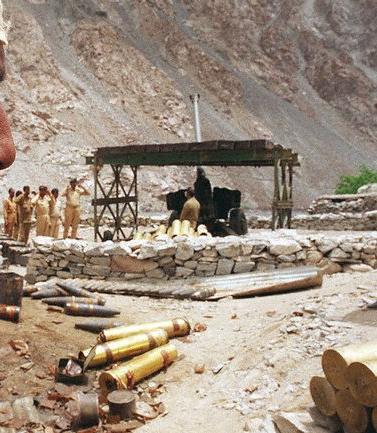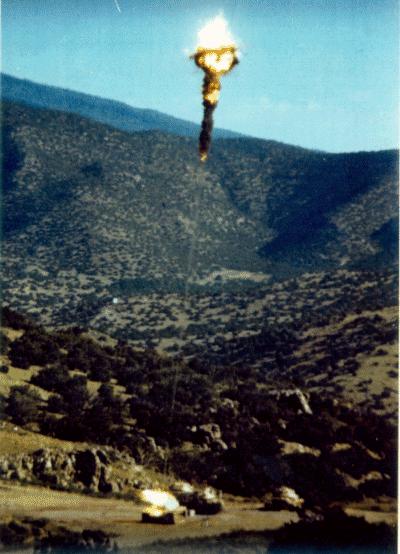Patriot
New Member
- Joined
- Apr 11, 2010
- Messages
- 1,761
- Likes
- 544
We need artillary of all types specially the one with light weight accurate with saturation precision FCM. As per our threat profile against China is conscerned we need ULH M777 & SLWH Pegasus 155mm , both these can be easily transported by C-130 & helicopters.
Pegasus howitzer design features
Pegasus is made of lightweight materials including titanium and high alloy aluminium. The materials used in the structure provide the strength and stability to resist the recoil force of a 155mm system.
The design incorporates several sub-systems such as an auxiliary power unit (APU), ammunition loading system, mechanical sight and recoil management system.
The 5.4t howitzer has an overall length of 10m, a width of 2.75m and a height of 2.4m. It can be operated by a crew of six to eight members.
Fire control, weaponry and ammunition
The gun can fire at a burst rate of three rounds in 24 seconds. The maximum rate of fire of the gun is four rounds a minute for three minutes and sustained rate is two rounds a minute for 30 minutes. Pegasus can fire extended range munitions up to a range of 30km.
It can be quickly prepared for deployment in less than 2.5 minutes. The advanced mechanical sight fitted on the gun can survive firing shocks of up to 90Gs.
The ammunition loading system powered by the APU automatically loads ammunition in to gun. This will reduce crew fatigue and enable the gun crew to operate the howitzer for long durations at a burst rate of three rounds in 24 seconds.

Engine onboard the SLWH Pegasus light weight howitzer

Pegasus is powered by an independent Lombardini 9LD625-2 air cooled diesel engine delivering a power output of 21kW.
The engine provides self-propelled capability at a speed of up to 12km/h for short-range. This feature gives the howitzer shoot and scoot ability to survive from the vehicles and artillery units equipped with fire-finder tracking radars.
For Truck Mounted Gun System my choice is Caesar 155mm, 52-calibre barrel
Caesar is equipped with a 155mm, 52-calibre barrel and can maintain a firing rate of six to eight rounds a minute in sustained fire, or three rounds in 15 seconds in rapid fire.
The FAST-Hit computerised fire management system, developed jointly by Nexter and EADS Defense Electronics, an Intertechnique ROB4 muzzle velocity radar system and a SAGEM Sigma 30 navigation system and global positioning system (GPS) are fitted so there is no requirement for topographical teams and goniometers.
The weapon has an automatic hydraulic laying system and the loading system is semi-automatic.
The gun can be set into and out of action in under a minute. The weapon system configuration and the provision of hydraulic drives give a time of approximately 30 seconds to take the Caesar out of battery.
A unit of eight Caesar self-propelled artillery vehicles can dispense, in less than one minute, more than 1t of projectiles, 1,500 bomblets or 48 smart anti-tank munitions on targets at ranges up to 40km.

Caesar-Munition
Munitions
Caesar is capable of using a wide range of ammunition for deployment against protected and unprotected targets, to create counter-mobility obstacles to block the manoeuvres of enemy armoured forces and to obscure or illuminate an area.
Caesar can fire conventional high-explosive (HE) or new-generation cargo rounds, which provide increased accuracy and terminal effectiveness.
The Ogre shell, which is in series production for the French Army, is an anti-tank and fragmentation bomblet dispensing round for use against relatively unprotected area targets such as command posts, artillery batteries, light armoured vehicles or logistic sites.
Ogre dispenses 63 bomblets, each fitted with a self-destruct mechanism. The bomblets are capable of penetrating more than 90mm of armour. A salvo of six Ogre shells releases 378 bomblets to saturate an area of 3ha at a range of 35km.
The Bonus round carries two smart anti-tank submunitions to a range of 34km. A top-attack flight profile delivers the explosively formed penetrator (EFP) warhead to the roof of the tank which is generally more vulnerable than the heavily armour-protected sides and front.
Base bleed shells provide a considerably increased range by filling the vacuum and reducing the turbulence behind the projectile without any loss of accuracy.
The maximum ranges are up to 42km for extended range full bore – base bleed (ERFB-BB) rounds.
Tracked SPH
Donar self-propelled autonomous air deployable howitzer


Armament
The DONAR is armed with a 155mm (52 cal.) cannon. DONAR's maximum range amounts to more than 56 kilometres. This 155 mm / 52. calibre artillery system combines a full automatic and independent firing module, fully automated loading and laying system with 30 shell magazine. Despite a marked reduction in weight and size, the gun module is operational without any additional stabilization and provides a 360-degree azimuth range. Maximum range of fire depends on projectile and charge combination. It is 30 km with standard and 40 km with rocket assisted projectile, however using the South African VLAP projectile a range of 56 km can be achieved. Maximum rate of fire is 6 rounds per minute; however this might be increased to 8 in production systems.
Thanks to the system's autonomy, the DONAR fits seamlessly into the networked and centralised command and control system (network-centric warfare). The Donar is fitted with NBC protection and automatic fire suppression systems. Standard equipment includes an inertial reference unit with a GPS (Global Positioning System) connection. It also has a muzzle velocity measuring system that feeds information into the onboard fire-control system. Krauss-Maffei Wegmann claims that the AGM can engage moving as well as stationary targets. A vehicle independent auxiliary power unit is installed as standard and this allows the complete AGM to be run with the main MLRS carrier engine shut down. The DONAR can be airlifted by the Airbus A400M, however it is too large for current C-130 Hercules and C-160.
There very nice info given in the below article by Dr. Carlo Kopp
Artillary in Digital Age
[PDF]http://www.ausairpower.net/SP/DT-Guided-Artillery-Oct-2010.pdf[/PDF]
Pegasus howitzer design features
Pegasus is made of lightweight materials including titanium and high alloy aluminium. The materials used in the structure provide the strength and stability to resist the recoil force of a 155mm system.
The design incorporates several sub-systems such as an auxiliary power unit (APU), ammunition loading system, mechanical sight and recoil management system.
The 5.4t howitzer has an overall length of 10m, a width of 2.75m and a height of 2.4m. It can be operated by a crew of six to eight members.
Fire control, weaponry and ammunition
The gun can fire at a burst rate of three rounds in 24 seconds. The maximum rate of fire of the gun is four rounds a minute for three minutes and sustained rate is two rounds a minute for 30 minutes. Pegasus can fire extended range munitions up to a range of 30km.
It can be quickly prepared for deployment in less than 2.5 minutes. The advanced mechanical sight fitted on the gun can survive firing shocks of up to 90Gs.
The ammunition loading system powered by the APU automatically loads ammunition in to gun. This will reduce crew fatigue and enable the gun crew to operate the howitzer for long durations at a burst rate of three rounds in 24 seconds.

Engine onboard the SLWH Pegasus light weight howitzer

Pegasus is powered by an independent Lombardini 9LD625-2 air cooled diesel engine delivering a power output of 21kW.
The engine provides self-propelled capability at a speed of up to 12km/h for short-range. This feature gives the howitzer shoot and scoot ability to survive from the vehicles and artillery units equipped with fire-finder tracking radars.
For Truck Mounted Gun System my choice is Caesar 155mm, 52-calibre barrel
Caesar is equipped with a 155mm, 52-calibre barrel and can maintain a firing rate of six to eight rounds a minute in sustained fire, or three rounds in 15 seconds in rapid fire.
The FAST-Hit computerised fire management system, developed jointly by Nexter and EADS Defense Electronics, an Intertechnique ROB4 muzzle velocity radar system and a SAGEM Sigma 30 navigation system and global positioning system (GPS) are fitted so there is no requirement for topographical teams and goniometers.
The weapon has an automatic hydraulic laying system and the loading system is semi-automatic.
The gun can be set into and out of action in under a minute. The weapon system configuration and the provision of hydraulic drives give a time of approximately 30 seconds to take the Caesar out of battery.
A unit of eight Caesar self-propelled artillery vehicles can dispense, in less than one minute, more than 1t of projectiles, 1,500 bomblets or 48 smart anti-tank munitions on targets at ranges up to 40km.

Caesar-Munition
Munitions
Caesar is capable of using a wide range of ammunition for deployment against protected and unprotected targets, to create counter-mobility obstacles to block the manoeuvres of enemy armoured forces and to obscure or illuminate an area.
Caesar can fire conventional high-explosive (HE) or new-generation cargo rounds, which provide increased accuracy and terminal effectiveness.
The Ogre shell, which is in series production for the French Army, is an anti-tank and fragmentation bomblet dispensing round for use against relatively unprotected area targets such as command posts, artillery batteries, light armoured vehicles or logistic sites.
Ogre dispenses 63 bomblets, each fitted with a self-destruct mechanism. The bomblets are capable of penetrating more than 90mm of armour. A salvo of six Ogre shells releases 378 bomblets to saturate an area of 3ha at a range of 35km.
The Bonus round carries two smart anti-tank submunitions to a range of 34km. A top-attack flight profile delivers the explosively formed penetrator (EFP) warhead to the roof of the tank which is generally more vulnerable than the heavily armour-protected sides and front.
Base bleed shells provide a considerably increased range by filling the vacuum and reducing the turbulence behind the projectile without any loss of accuracy.
The maximum ranges are up to 42km for extended range full bore – base bleed (ERFB-BB) rounds.
Tracked SPH
Donar self-propelled autonomous air deployable howitzer


Armament
The DONAR is armed with a 155mm (52 cal.) cannon. DONAR's maximum range amounts to more than 56 kilometres. This 155 mm / 52. calibre artillery system combines a full automatic and independent firing module, fully automated loading and laying system with 30 shell magazine. Despite a marked reduction in weight and size, the gun module is operational without any additional stabilization and provides a 360-degree azimuth range. Maximum range of fire depends on projectile and charge combination. It is 30 km with standard and 40 km with rocket assisted projectile, however using the South African VLAP projectile a range of 56 km can be achieved. Maximum rate of fire is 6 rounds per minute; however this might be increased to 8 in production systems.
Thanks to the system's autonomy, the DONAR fits seamlessly into the networked and centralised command and control system (network-centric warfare). The Donar is fitted with NBC protection and automatic fire suppression systems. Standard equipment includes an inertial reference unit with a GPS (Global Positioning System) connection. It also has a muzzle velocity measuring system that feeds information into the onboard fire-control system. Krauss-Maffei Wegmann claims that the AGM can engage moving as well as stationary targets. A vehicle independent auxiliary power unit is installed as standard and this allows the complete AGM to be run with the main MLRS carrier engine shut down. The DONAR can be airlifted by the Airbus A400M, however it is too large for current C-130 Hercules and C-160.
There very nice info given in the below article by Dr. Carlo Kopp
Artillary in Digital Age
[PDF]http://www.ausairpower.net/SP/DT-Guided-Artillery-Oct-2010.pdf[/PDF]








